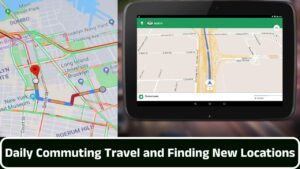Daily Commuting Travel and Finding New Locations
Introduction
Google Maps, launched in 2005, has redefined navigation with its detailed maps, satellite imagery, and a suite of features for route planning and local discovery. It has grown to serve over a billion users globally, becoming indispensable for daily commuting, travel, and finding new locations.

Core Features
Google Maps offers a wide array of tools:
- Mapping and Navigation: Users can access highly detailed maps with interactive capabilities. It provides turn-by-turn navigation for driving, walking, biking, and public transit, optimizing routes based on real-time data.
- Street View: A standout feature that provides 360-degree views of locations worldwide, allowing users to explore streets, landmarks, and neighborhoods virtually.
- Local Business Information: Google Maps is a powerful tool for discovering local businesses. Listings include details like hours, contact information, photos, and reviews, making it easier to decide where to dine, shop, or visit.
- Public Transit Directions: Public transit details are provided in many urban areas, showing routes, schedules, and live updates for buses, trains, and subways.
- Offline Maps: Users can download maps to use offline, ensuring they have access to navigation even in areas with limited connectivity, ideal for travelers.
User Interface and Experience
The app’s intuitive design makes it easy for users to navigate through various features. With responsive controls and options for voice commands, Google Maps enables hands-free use for safe driving. The app’s clean, organized layout allows quick access to search, navigation, and local recommendations, delivering a smooth and efficient user experience.
Technological Innovations
Google Maps employs cutting-edge technologies:
- AI and Machine Learning: Advanced algorithms optimize routes, predict traffic patterns, and personalize recommendations. AI also helps process immense data, providing accurate, real-time updates.
- Real-Time Data Processing: Google Maps continuously processes data from GPS signals, traffic sensors, and public transit systems, allowing for timely updates on traffic and route changes.
Google Maps for Businesses
Google Maps has evolved into a robust platform for businesses:
- Google My Business: A free service that enables businesses to manage their profiles, including hours, location, photos, and reviews. This tool helps businesses connect with potential customers on Google Maps.
- Advertising: Businesses can advertise on Google Maps, placing ads in location-based searches. This feature helps boost visibility for companies and drive foot traffic to local businesses.
Social Features
To enhance user engagement, Google Maps includes social components:
- User Contributions: People can contribute by adding places, updating information, or uploading photos. These contributions help keep Google Maps accurate and up-to-date.
- Reviews and Ratings: Users can review businesses, which aids others in making informed decisions while providing businesses with valuable feedback.
- Lists and Sharing: Users can create lists of favorite places and share them with friends and family, adding a community-driven, social aspect to Google Maps.
Safety and Privacy
Google Maps prioritizes user privacy and security by anonymizing data and offering settings to control location sharing. However, concerns remain about the extent of data Google collects. Users can manage their privacy settings, such as disabling location history, to retain control over their data.
Global Impact
Google Maps has had significant social and economic effects:
- Economic Benefits: It drives economic growth by helping users discover local businesses, supporting small businesses, and increasing their visibility.
- Urban Planning: City planners leverage Google Maps data for infrastructure projects and transportation planning, using traffic patterns and population density to inform decisions.
- Tourism: Tourists benefit from Google Maps’ navigation and local information, which enhances their travel experience and supports local economies by promoting popular attractions.
Future Prospects
Looking forward, Google Maps is set to incorporate new technologies like augmented reality (AR) to provide real-time directions on mobile devices. AI advancements may further refine route optimization and recommendations. Potential collaborations with autonomous vehicles and smart city projects highlight the platform’s expanding role in shaping future transportation.
Conclusion
Google Maps has become a central part of modern navigation, providing unparalleled tools for finding, exploring, and connecting with places and businesses. Its combination of real-time data, user contributions, and cutting-edge technology has reshaped navigation and continues to influence how people interact with their surroundings. As it evolves, Google Maps is poised to further impact urban planning, business development, and the travel experience globally.
